NCERT Solutions Class 12 Biology Chapter 16 Environmental Issues have been provided below and is also available in Pdf for free download. The NCERT solutions for Class 12 Biology have been prepared as per the latest syllabus, NCERT books and examination pattern suggested in Class 12 by CBSE, NCERT and KVS. Questions given in NCERT book for Class 12 Biology are an important part of exams for Class 12 Biology and if answered properly can help you to get higher marks. Refer to more Chapter-wise answers for NCERT Class 12 Biology and also download more latest study material for all subjects. Chapter 16 Environmental Issues is an important topic in Class 12, please refer to answers provided below to help you score better in exams
Chapter 16 Environmental Issues Class 12 Biology NCERT Solutions
Students of Class 12 studying Biology are advised to carefully go through the NCERT questions and their detailed answers provided here for the chapter Chapter 16 Environmental Issues. The questions in the NCERT textbook for Class 12 Biology form an important part of school exams. These solutions for Class 12 follow a step-by-step approach and are highly beneficial for exam preparation. Scroll down to view detailed, chapter-wise solutions for Chapter 16 Environmental Issues and explore more NCERT solutions and free study materials for Biology and other subjects of Class 12.
Chapter 16 Environmental Issues NCERT Solutions Class 12 Biology
Question. What are the various constituents of domestic sewage? Discuss the effects of sewage discharge on a river.
Answer. The various constituents of domestic sewage are:
(i) Suspended solids: Grit made up of sand, silt and clay.
(ii) Colloidal materials: Including faecal matter, bacteria, paper fibres, cloth fibres, etc.
(iii) Dissolved solids: They are inorganic nutrients (e.g., nitrates, ammonium salts, calcium salts), toxic metal ions and organic compounds.
(iv) Pathogens: A number of pathogens cause various diseases like typhoid, cholera, dysentery, etc.
Effect of sewage discharge on a river:
Domestic sewage mainly contains biodegradable organic wastes which are decomposed by decomposers like bacteria and other micro-organisms. Decomposers require oxygen for their activity and hence BOD (Biochemical Oxygen Demand) increases. Many aquatic organisms die due to lack of dissolved oxygen. Domestic sewage contains nitrogen and phosphorus which favour the excess growth of algae called algal bloom. Excessive growth of water hyacinth causes imbalance in water ecosystem and thus aquatic animals die.
Question. List all the wastes that you generate, at home, school or during your trips to other places, could you very easily reduce? Which would be difficult or rather impossible to reduce?
Answer. Wastes are used up, unwanted and discarded materials which have to be disposed off.
(i) Wastes generated at home include kitchen waste, food left-overs, old and torn clothes, paper,polythene bags, plastic bags, carry bags, broken glass, carton boxes, tissue papers, etc.
(ii) Wastes generated at school include pens, papers, chalk, plastic envelopes, polythene, food wrappers, waste food, etc.
(iii) Wastes generated during trips include food wrappers, waste papers, polythene, disposable plates, spoons, cups, discarded food, etc.
Yes, we can reduce most of the wastes by its judicious use. Biodegradable wastes include all articles of organic origin, i.e., food wastes, waste paper, wood, leather articles and disposable articles which will be broken down by micro-organisms. Non-biodegradable wastes can be recycled and often taken away by rag-pickers. It is difficult to reduce non-biodegradable wastes.
Question. Discuss the causes and effects of global warming. What measures need to be taken to control global warming?
Answer.
- The gradual continuous increase in average temperature of surface of the Earth as a result of increase in concentration of greenhouse gases is termed as global warming.
(i) Cause
- Increase in the level of greenhouse gases (CO2, methane, etc.) in the atmosphere.
These gases allow the heat waves to reach earth but prevent their escape and thus the earth becomes warm.
(ii) Effects
- The temperature of the earth has increased by 0.6°C in the last three decades, which will lead to changes in precipitation patterns.
- Rise in temperature leads to deleterious changes in environment resulting in odd climatic changes called El Nino effect.
- The rise in temperature will lead to the increased melting of polar ice caps which will cause the rise in sea level and many coastal areas will be submerged.
- Increased temperature will lead to increased weed growth, eruption of diseases and pests. Thus, crop productivity will decrease.
(iii) Control of global warming
- Global warming can be controlled by:
(a) Reducing deforestation
(b) Planting trees (afforestation)
Question. Match the items given in column A and B.
Column A Column B
(a) Catalytic converter (i) Particulate matter
(b) Electrostatic precipitator (ii) Carbon monoxide and nitrogen oxides
(c) Earmuffs (iii) High noise level
(d) Landfills (iv) Solid wastes
Answer. (a)–(ii), (b)–(i), (c)–(iii), (d)–(iv).
Question. Write critical notes on the following:
(a) Eutrophication (b) Biological magnification
(c) Groundwater depletion and ways for its replenishment.
Answer.
(a) Eutrophication:
- It is defined as the natural aging of a lake by biological enrichment of its water.
- Water in a young lake is cold and clear to support life.
- With time, it is enriched with nutrients like nitrogen and phosphorus by streams draining into it.
- This encourages growth of aquatic life—plant and animal life.
- Organic remains deposit at the bottom of the lake and with time makes the water warmer and shallower.
- Marsh plants take root in the shallows and begin to fill in original lake basin.
- Eventually, floating plants develop in the lake, finally converting it into land.
- According to climate, size of the lake and other factors, natural ageing of lake may span up to thousands of years.
- The accelerated aging of lakes due to sewage, agricultural and industrial wastes is called cultural or accelerated eutrophication.
- Prime contaminants are nitrates and phosphates (plant nutrients) that overstimulate algal growth. This causes unsightly scum, unpleasant odour, etc. Which depletes the amount of dissolved oxygen. Other pollutant may also poison fish, whose decomposing remains further depletes the dissolved O2 and thus choke a lake to death.
Heated (thermal) waste waters flowing out of electricity generating units like thermal power plants also act as pollutants.
Effect: (i) Eliminate or reduce number of organisms sensitive to high temperature.
(ii) Enhance growth of plant and fish in extremely cold areas.
(iii) Cause damage to indigenous flora and fauna.
(b) Biological magnification: Unknowingly some harmful chemicals enter our bodies through the food chain. We use several pesticides and other chemicals to protect our crops from diseases and pests. These chemicals are either washed down into the soil or into the water bodies. From the soil, these are absorbed by the plants along with water and minerals, and from the water bodies these are taken up by aquatic plants and animals. This is one of the ways in which they enter the food chain. As these chemicals are not degradable, these get accumulated progressively at each trophic level. As human beings occupy the topmost level in any food chain, the maximum concentration of these chemicals get accumulated in our bodies. This phenomenon is known as biological magnification.
(c) Groundwater depletion and ways for its replenishment: Groundwater is depleting due to various reasons like deforestation, agricultural use, daily use at home, etc. Groundwater level is going down in several states due to its unjudicious use. Replenishment of groundwater can be done by rainwater harvesting and reforestation. Rainwater can be collected on the roof top of the buildings and can be stored underground for later use.
Question. Why ozone hole forms over Antarctica? How will enhanced ultraviolet radiation affect us?
Answer. In Antarctica, winter months receive no sunlight and thus the temperature is extremely low (– 85°C). It facilitates the formation of ice clouds which provide the catalytic surface on which the chlorine atoms react with ozone and degrade it. This happens with the return of sun to Antarctica in spring (September and October). Therefore, an ozone hole appears in Antarctica in spring.
Enhanced ultraviolet radiation will cause the following effects:
(i) Damage skin cells, ultimately leading to skin cancer.
(ii) Mutation will result due to damage of DNA.
(iii) Malfunctioning of immune system.
Question. Discuss the role of women and communities in protection and conservation of forests.
Answer. Women and communities played an important role in protection and conservation of forests. In 1731, a Bishnoi woman, Amrita Devi showed exemplary courage by hugging a tree to prevent its cutting. Amrita Devi Bishnoi Wildlife protection Award is being awarded by the Government of India to individuals or communities from rural areas that show extraordinary courage and dedication in protecting wildlife. In Garhwal, local women hugged trees to prevent the contractor from cutting down trees.
Question. What measures, as an individual, you would take to reduce environmental pollution?
Answer. I will take following measures to reduce environmental pollution:
(i) Use of renewable energy resources.
(ii) Use of television and other instruments, at low pitch.
(iii) Minimum use of fossil fuel.
(iv) No tobacco smoking.
(v) Planting more trees.
Question. Discuss briefly the following:
(a) Radioactive wastes
(b) Defunct ships and e-wastes
(c) Municipal solid wastes
Answer.
(a) Radioactive wastes: These are nuclear wastes which are most potent pollutants as they cause mutations. These cannot be reused or recycled and are disposed off carefully to prevent leakage.
(i) Accidents: There are accidental leakage as in Three Mile Island and Chernobyl incidents.
(ii) Radioactive waste disposal: Radiation given off by nuclear waste is extremely damaging to living organisms as it causes mutation at an extremely high rate, causing cancer.
Therefore, nuclear waste is an extremely potent pollutant.
(b) Defunct ships: Old defunct ships are dismantled to obtain scrap metals. Defunct ships contains toxicants like asbestos, mercury, lead, tributylin, etc. The workers engaged in ship are exposed to toxic chemicals. The coastal areas connected with ship breaking yard also become polluted.
e-wastes: These are the wastes (like irreparable computers and other electronic goods) generated in the developed countries and exported to developing countries including India,
China and Pakistan where metals like gold, nickel, silicon, copper, iron, etc., are recovered during recycling process. Recycling is done manually by workers and hence they are exposed to some toxic substances.
(c) Municipal solid wastes: Wastes produced from homes, offices, schools, hospitals, etc., are collected and disposed off by the municipality. These generally consists of paper, leather,textile, rubber, glass, etc. Sanitary landfills are used to dump these wastes.
Question. What initiatives were taken for reducing vehicular air pollution in Delhi? Has air quality improved in Delhi?
Answer. Delhi Government took following initiatives to reduce vehicular air pollution:
(i) Switching over to CNG for public transport vehicle.
(ii) Application of Euro II norms for vehicles.
(iii) Use of unleaded petrol.
(iv) Use of low-sulphur petrol and diesel.
(v) Use of catalytic converter in vehicles.
(vi) Phasing out of old vehicles.
In recent years, air quality of Delhi has improved with a substantial fall in pollutant gases like level between 1997 and 2005.
Question. Discuss briefly the following:
(a) Greenhouse gases (b) Catalytic converter (c) Ultraviolet B
Answer. (a) Greenhouse gases: The gases which allow solar radiations to pass through them but retain and partially reflect back radiation of longer wavelength are called greenhouse gases, e.g.,CO2, NO2, CH4, etc. These gases are required to keep earth warm and hospitable. They prevent a substantial part of long wave radiations emitted by earth to escape into space.Rather greenhouse gases radiate a part of this energy back to the earth.
(b) Catalytic converter: Refer to Basic Concepts Point 2 (iv)(c).
(c) Ultraviolet B: These are UV radiations with wavelength ranging between 280–320 nm. They are harmful radiations that penetrate through the ozone hole to reach the earth. Ozone shield is thinning over the equator. UV-B radiation causes cataract and skin cancer in human beings.
High levels of UV-B radiation damages DNA of an individual.
NCERT Solutions for Class 12 Biology Chapter 16 Environmental Issues Multiple Choice Questions
Question. In an area where DDT had been used extensively population of birds declined significantly because
(a) birds stopped laying eggs
(b) earthworms in the area got eradicated
(c) cobras were feeding exclusively on birds
(d) many of the birds laid eggs, did not hatch
Answer. D
Question. Eutrophication is often seen in
(a) deserts
(b) fresh water lakes
(c) ocean
(d) mountains
Answer. B
Question. In the textbook you came across “Three Mile Island and Chernobyl disasters associated with accidental leakage of radioactive wastes.” In India we had Bhopal gas tragedy. It is associated with which of the following?
(a) CO2
(b) Methyl Isocyanate
(c) CFC
(d) Methyl Cyanate
Answer. B
Question. “Good ozone” is found in the
(a) mesosphere
(b) troposphere
(c) stratosphere
(d) ionosphere
Answer. C
Question. Compressed Natural Gas (CNG) is
(a) propane
(b) methane
(c) ethane
(d) butane
Answer. B
Question. World’s most problematic aquatic weed is
(a) Azolla
(b) Wolffia
(c) Eichhornia
(d) Trapa
Answer. C
Question. Nuisance growth of aquatic plants and bloom-forming algae in natural waters is generally due to high concentrations of
(a) carbon
(b) sulphur
(c) calcium
(d) phosphorus
Answer. D
Question. Catalytic converters are fitted into automobiles to reduce emission of harmful gases. Catalytic converters change unburnt hydrocarbons into
(a) carbon dioxide and water
(b) carbon monoxide
(c) methane
(d) carbon dioxide and methane
Answer. A
Question. Algal blooms impart a distinct colour to water due to
(a) their pigments
(b) excretion of coloured substances
(c) formation of coloured chemicals in water facilitated by physiological degradation of algae.
(d) absorption of light by algal cell wall.
Answer. A
Question. Which of the following exhibits biomagnification?
(a) SO2
(b) Mercury
(c) DDT
(d) Both (b) and (c)
Answer. D
Question. The green scum seen in the fresh water bodies is:
(a) blue green algae
(b) red algae
(c) green algae
(d) both (a) and (c)
Answer. D
Question. The expanded form of DDT is
(a) dichloro diphenyl trichloroethane
(b) dichloro diethyl trichloroethane
(c) dichloro dipyrydyl trichloroethane
(d) dichloro diphenyl tetrachloroacetate
Answer. A
Question. Which of the following material takes the longest time for biodegradation?
(a) Cotton
(b) Paper
(c) Bone
(d) Jute
Answer. C
Question. Choose the incorrect statement.
(a) The Montreal protocol is associated with the control of emission of ozone depleting substances
(b) Methane and carbon dioxide are green house gases
(c) Dobson units are used to measure oxygen content of air
(d) Use of incinerators is crucial to disposal of hospital wastes
Answer. C
Question. Among the following which one causes maximum indoor chemical pollution?
(a) Burning coal
(b) Burning cooking gas
(c) Burning mosquito coil
(d) Room spray
Answer. A
Question. Biochemical oxygen demand (BOD) in a river water
(a) has no relationship with concentration of oxygen in the water
(b) gives a measure of Salmonella in the water
(c) increases when sewage gets mixed with river water
(d) remains unchanged when algal bloom occurs.
Answer. C
Question. Montreal Protocol aims at
(a) biodiversity conservation
(b) control of water pollution
(c) control of CO2 emission
(d) reduction of ozone depleting substances
Answer. D
Question. The major source of noise pollution world wide is due to
(a) office equipment
(b) transport system
(c) sugar, textile and paper industries
(d) oil refineries and thermal power plants.
Answer. B
Question. Increased rate of skin cancer and mutation might be because of
(a) increase in CO2 concentration
(b) increase in CO concentration
(c) ozone layer depletion
(d) acid rain
Answer. C
Question. Why is it necessary to remove sulphur from petroleum products?
(a) To reduce the emission of sulphur dioxide in exhaust fumes
(b) To increase efficiency of automobiles engines
(c) To use sulphur removed from petroleum for commercial purposes
(d) To increase the life span of engine silencers
Answer. A
Question. Non-biodegradable pollutants are created by
(a) nature
(b) excessive use of resources
(c) humans
(d) natural disasters
Answer. C
Question. The two gases making highest relative contribution to greenhouse gases are
(a) CO2 and CH4
(b) CH4 and N2O
(c) CFCs and N2O
(d) CO2 and N2O
Answer. A
Question. Which one of the following impurities is easiest to remove from wastewater?
(a) Bacteria
(b) Colloids
(c) Dissolved solids
(d) Suspended solids
Answer. D
Question. Match the following and choose the correct option.
Column I Column II
A. Environment Protection Act (i) 1974
B. Air Prevention & Control of Pollution Act (ii) 1987
C. Water Act (iii) 1986
D. Amendment of Air Act to include noise (iv) 1981 as an air pollutant
The correct matches is
(a) A-(iii), B-(iv), C-(i), D-(ii)
(b) A-(i), B-(iii), C-(ii), D-(iv)
(c) A-(iv), B-(i), C-(ii), D-(iii)
(d) A-(iii), B-(iv), C-(ii), D-(i)
Answer. A
Question. Match the items in column I and column II and choose the correct option.
Column I Column II
A. UV (i) Biomagnification
B. Biodegradable Organic matter (ii) Eutrophication
C. DDT (iii) Snow blindness
D. Phosphates (iv) BOD
The correct match is:
(a) A-(ii), B-(i), C-(iv), D-(iii)
(b) A-(iii), B-(ii), C-(iv), D-(i)
(c) A-(iii), B-(iv), C-(i), D-(ii)
(d) A-(iii), B-(i), C-(iv), D-(ii)
Answer. C
Question. Match the items given in Column I with those in Column II and select the correct option given below:
Column I Column II
A. Eutrophication (i) UV-B radiation
B. Sanitary landfills (ii) Deforestation
C. Snow blindness (iii) Nutrient enrichment
D. Jhum cultivation (iv) Waste diposal
(a) A-(iii), B-(iv), C-(i), D-(ii)
(b) A-(i), B-(iii), C-(iv), D-(ii)
(c) A-(ii), B-(i), C-(iii), D-(iv)
(d) A-(i), B-(ii), C-(iv), D-(iii)
Answer. A
NCERT Solutions for Class 12 Biology Chapter 16 Environmental Issues Assertion-Reason Questions
In the following questions a statement of assertion followed by a statement of reason is given. Choose the correct answer out of the following choices.
(a) Assertion and reason both are correct statements and reason is correct explanation for assertion.
(b) Assertion and reason both are correct statements but reason is not correct explanation for assertion.
(c) Assertion is correct statement but reason is wrong statement.
(d) Assertion is wrong statement but reason is correct statement.
Question. Assertion : Eutrophication shows increase in productivity in water.
Reason : With increasing eutrophication, the diversity of phytoplankton increases.
Answer. B
Question. Assertion : Inhabitants close to very busy airports are likely to experience health hazards.
Reason : Sound level of jet aeroplanes usually exceeds 160 dB.
Answer. B
Question. Assertion : Suspended particulate matter (SPM) is an important pollutant released by diesel vehicles.
Reason : Catalytic convertors greatly reduce pollution caused by automobiles.
Answer. B
Question. Assertion : Presently the global atmosphere is warming up.
Reason : The depletion of stratospheric ozone layer has resulted in increase in UV radiations reaching the earth.
Answer. B
Question. Assertion : Deforestation is one main factor contributing to global warming.
Reason : Increased greenhouse gases capture the infra red rays from the sun.
Answer. A
Question. Assertion : UV radiation causes photodissociation of ozone into O2 and O3, thus causing damage to the stratospheric ozone layer.
Reason : Ozone hole is not resulting in global warming and climate change.
Answer. C
Question. Assertion : The sharp decline in dissolved oxygen in the water body causes mortality of aquatic creatures.
Reason : Micro-organisms involved in bio-degradation of organic matter in the water body consume a lot of oxygen.
Answer. C
Question. Assertion : The concentration of ozone over Africa is decreasing leading to thinning of ozone layer.
Reason : Ozone depleting substances react with ozone present in stratosphere and destroy the same.
Answer. D
Question. Assertion : Presence of large amounts of nutrients in water causes algal bloom.
Reason : Algal bloom causes deterioration of the water quality and may lead to fish mortality.
Answer. B
Question. Assertion : Motor vehicles equipped with catalytic convertors should use unleaded petrol.
Reason : Lead in petrol leads to blockage of catalytic convertors.
Answer. C
NCERT Solutions for Class 12 Biology Chapter 16 Environmental Issues Case-based/Source-based Question
1. Study the graph given below and answer the questions that follow:
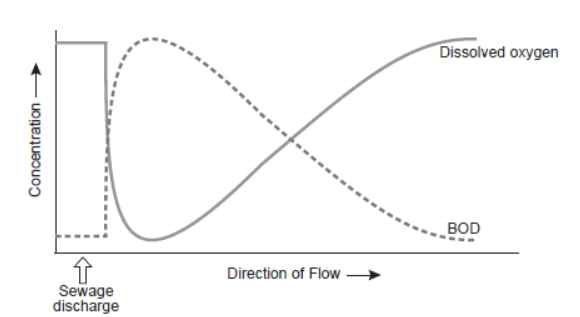
Question. What is the relationship between dissolved oxygen and biochemical oxygen demand (BOD)?
Answer. BOD refers to the amount of oxygen consumed if all the organic matter in one litre of water were oxidised by bacteria. Thus, greater the BOD, lesser will be the dissolved oxygen in sewage discharge.
Question. Mention their effect on aquatic life in the river.
Answer. Effects on aquatic life:
(a) It causes high mortality rate of aquatic animals.
(b) The excessive nutrients facilitate algal growth causing algal bloom.
2. Two types of aquatic organisms in a lake show specific growth patterns as shown below, in a brief period of time. The lake is adjacent to an agricultural land extensively supplied with fertilisers.
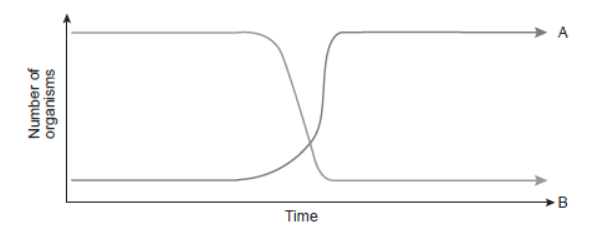
Answer the questions based on the facts given above:
Question. Name the organisms depicting the patterns A and B.
Answer. A-algae/planktonic (free floating) algae
B-fish/aquatic animals
Question. State the reason for the growth pattern seen in A.
Answer. Due to excessive loading of nutrients or fertilisers from adjacent agricultural land, results in increase in nutrients.
Question. Write the effects of the growth patterns seen above.
Answer. Effects: decrease in dissolved oxygen (DO), increase in BOD, fish mortality, unpleasant odour/eutrophication.
3. Study the given aquatic food chain and answer the questions that follow:
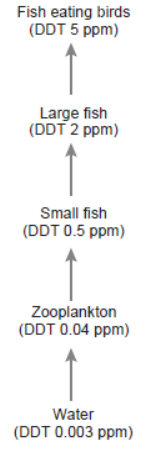
Question. Name the phenomenon responsible for the increase in DDT content.
Answer. Biological magnification
Question. Lower BOD of a water body helps reappearance of clean-water organisms. Explain.
Answer. Lowering of Biological Oxygen Demand (BOD) results in decreased biodegradable material in the water body. This results in reduced microbial decomposition. When there is no decomposition, oxygen utilisation is reduced and there is more Dissolved Oxygen (DO) available. Thus, clean water-organisms reappear.
Question. A crane had DDT level at 5 ppm in its body. What would happen to the population of such birds? Explain giving reasons.
Answer. DDT being a toxic substance gets accumulated in the organism and passes on to the next higher trophic level because it cannot be metabolised or excreted. Thus, concentration of DDT has increased in the birds in the given case. The high concentration of DDT disturbs the calcium metabolism in birds, causes thinning of eggshells, their premature breaking and eventually causes a decline in the bird population.
The phenomenon is called biomagnification
4. Sunlight energy at outermost atmosphere is reflected by the atmospheric gases and clouds.
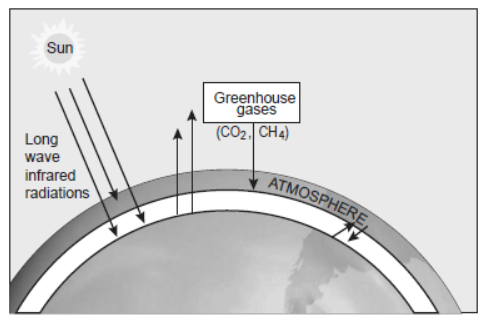
Answer the questions given below based on the information given.
Question. Mention the effect of global warming on the geographical distribution of stenothermals like amphibiAnswer.
Answer. Due to global warming, stenothermals would either migrate or die due to change in the temperature.
Question. Mention the effect of UV rays on DNA and proteins in living organisms.
Answer. The high energy of UV rays breaks the chemical bonds within DNA and protein molecules.
Question. How is snow-blindness caused in humans?
Answer. In human eye, cornea absorbs UV-B radiation, and a high dose of UV–B causes inflammation of cornea leading to snow-blindness.
5. The figure given below shows the relative contribution of various greenhouse gases to global warming. Answer the questions based on the figure.
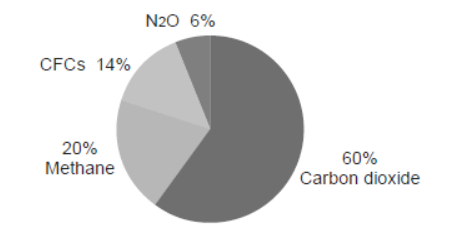
Question. Name two greenhouse gases produced by anaerobic microbes.
Answer. Carbon dioxide and methane
Question. It is a common practice to plant tree and shrubs near the boundary walls of building. What purpose do they serve?
Answer. The plant growing near the boundary wall act as barrier for sound pollution and act as dust catchers.
Question. Why is global warming a warning to mankind?
Answer. Global warming has resulted in climatic changes. This has disrupted the lifecycles of many organisms and has caused melting of ice caps.
NCERT Solutions for Class 12 Biology Chapter 16 Environmental Issues Very Short Answer Questions
Question. Mention the effect of UV rays on DNA and proteins in living organisms.
Answer. The high energy of UV rays breaks the chemical bonds within DNA and protein molecules.
Question. State the effect of UV-B on human eye.
Answer. UV-B is absorbed by human eye and at high dose, it causes inflammation of cornea. This is called snow-blindness cataract.
Question. Name the greenhouse gases that contribute to total global warming.
Answer. N2O, CFC, CH4, CO2.
Question. State the purpose of signing the Montreal Protocol.
Answer. Montreal Protocol, was signed at Montreal, in 1987 to curb the emission of ozone depleting substances.
Question. What is reforestation?
Answer. Reforestation is the process of restoring a forest that once existed but was removed at some point of time in the past.
Question. An electrostatic precipitator in a thermal power plant is not able to generate high voltage of several thousands. Write the ecological implication because of it.
Answer. As a result of this particulate matter or dust particles will be released in the air causing air pollution.
Question. Mention two advantages for preferring CNG over diesel as an automobile fuel.
Answer. Advantages of CNG are:
(i) burns efficiently and leaves behind less unburnt residues
(ii) cheaper than petrol or diesel
(iii) causes less pollution
(iv) cannot be adulterated
(v) cannot be siphoned by thieves.
Question. Mention the effect of global warming on the geographical distribution of stenothermals like amphibians.
Answer. Due to global warming, stenothermals would either migrate or die due to change in the temperature.
Question. BOD of two samples of water A and B were 120 mg/L and 400 mg/L, respectively. Which sample is more polluted?
Answer. Sample B is more polluted than Sample A.
Question. How do algal blooms affect the life in water bodies?
Answer. (i) Algal bloom pollutes water and deteriorates the water quality by depleting the oxygen content. This turns the water toxic and increases its BOD.
(ii) Algal blooms lead to death of aquatic organisms due to oxygen depletion.
Question. Name an industry which can cause air pollution, thermal pollution and eutrophication.
Answer : Fertiliser factory.
Question. Name the city in which the entire public road transport runs on CNG.
Answer : Delhi.
Question. Eutrophication is the natural aging of a lake; mention any other feature which defines this term.
Answer : —Depletion of dissolved oxygen in water
—Nutrient enrichment (Any one)
Question. How do plants control pollution?
Answer : Plants absorb and assimilate the pollutants like CO2 and provide oxygen by the process of photosynthesis. This reduces the pollution.
| NCERT Solutions Class 12 Biology Chapter 2 Sexual Reproduction in Flowering Plants |
| NCERT Solutions Class 12 Biology Chapter 3 Human Reproduction |
| NCERT Solutions Class 12 Biology Chapter 4 Reproductive Health |
| NCERT Solutions Class 12 Biology Chapter 5 Principles of Inheritance and Variation |
| NCERT Solutions Class 12 Biology Chapter 6 Molecular Basis of Inheritance |
| NCERT Solutions Class 12 Biology Chapter 7 Evolution |
| NCERT Solutions Class 12 Biology Chapter 8 Human Health and Disease |
| NCERT Solutions Class 12 Biology Chapter 10 Microbes in Human Welfare |
| NCERT Solutions Class 12 Biology Chapter 11 Biotechnology Principles And Processes |
| NCERT Solutions Class 12 Biology Chapter 12 Biotechnology and its Applications |
| NCERT Solutions Class 12 Biology Chapter 13 Organisms and Populations |
| NCERT Solutions Class 12 Biology Chapter 14 Ecosystem |
| NCERT Solutions Class 12 Biology Chapter 15 Biodiversity and Conservation |
NCERT Solutions Class 12 Biology Chapter 16 Environmental Issues
The above provided NCERT Solutions Class 12 Biology Chapter 16 Environmental Issues is available on our website for free download in Pdf. You can read the solutions to all questions given in your Class 12 Biology textbook online or you can easily download them in pdf. The answers to each question in Chapter 16 Environmental Issues of Biology Class 12 has been designed based on the latest syllabus released for the current year. We have also provided detailed explanations for all difficult topics in Chapter 16 Environmental Issues Class 12 chapter of Biology so that it can be easier for students to understand all answers. These solutions of Chapter 16 Environmental Issues NCERT Questions given in your textbook for Class 12 Biology have been designed to help students understand the difficult topics of Biology in an easy manner. These will also help to build a strong foundation in the Biology. There is a combination of theoretical and practical questions relating to all chapters in Biology to check the overall learning of the students of Class 12.
You can download the NCERT Solutions for Class 12 Biology Chapter 16 Environmental Issues for latest session from StudiesToday.com
Yes, the NCERT Solutions issued for Class 12 Biology Chapter 16 Environmental Issues have been made available here for latest academic session
Regular revision of NCERT Solutions given on studiestoday for Class 12 subject Biology Chapter 16 Environmental Issues can help you to score better marks in exams
Yes, studiestoday.com provides all latest NCERT Chapter 16 Environmental Issues Class 12 Biology solutions based on the latest books for the current academic session
Yes, NCERT solutions for Class 12 Chapter 16 Environmental Issues Biology are available in multiple languages, including English, Hindi
All questions given in the end of the chapter Chapter 16 Environmental Issues have been answered by our teachers

